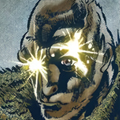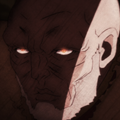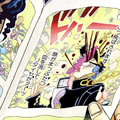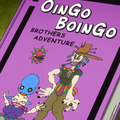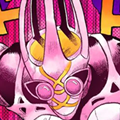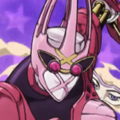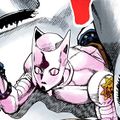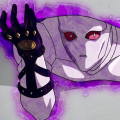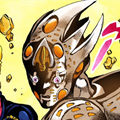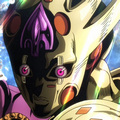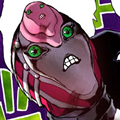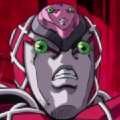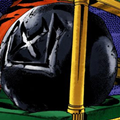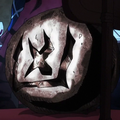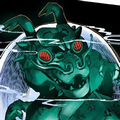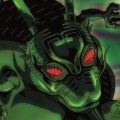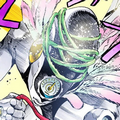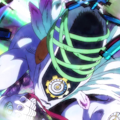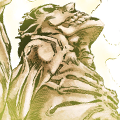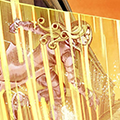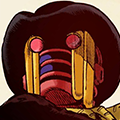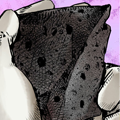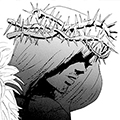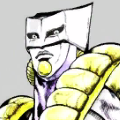Fate: Difference between revisions
Better to wait a bit before adding this Tag: Manual revert |
Tag: Manual revert |
||
| (22 intermediate revisions by 10 users not shown) | |||
| Line 1: | Line 1: | ||
{{Fighting Style Infobox |
|||
{{Quote|"The sequence" - the magnificence of music resides within the chord progression. Even Mozart once said to the Emperor that no note could be omitted from a piece. The human body is also made of a genetic sequence called DNA. Thus we cannot neglect the existence of that sequence of preestablished facts we call fate. But if everything is decided in advance by fate, we tend to think that the efforts we deploy everyday are vain. This is one of the points I have to consider when I tell a human epic. Is there a solution to that question?|[[Hirohiko Araki]], [[Volume 63]]}} |
|||
|title = Fate |
|||
| ⚫ | |||
|colors = PhantomBlood |
|||
|image = [[File:GWep39-1.png|{{ImageSize}}]] |
|||
|ja_kanji = 運命 |
|||
|ja_romaji = Unmei |
|||
|litname = Bringer of luck |
|||
|altnames = Destiny |
|||
|debut = [[Chapter 1]] |
|||
|animedebut = [[Episode 1]] |
|||
}} |
|||
{{Spoiler|1-9}} |
|||
{{Quote|There are those who say fate is something one carves out for themselves... But at the same time, there are situations in one's life where, caught between a rock and a hard place, they lack the opportunity to choose the right path!|[[Narrator]]|{{Ch|Chapter 517}}}} |
|||
| ⚫ | |||
The conflict between human will and fate serves as a major theme throughout the series, most prominently in ''[[Phantom Blood]]'', ''[[Diamond is Unbreakable]]'', ''[[Vento Aureo]]'', and ''[[Stone Ocean]]''. |
|||
==Summary== |
==Summary== |
||
{{Quote|Don't you understand? You lost to fate! It's fate to walk the path of justice!|Emporio Alnino to Enrico Pucci |
{{Quote|Don't you understand? You lost to fate! It's fate to walk the path of justice!|[[Emporio Alnino]] to [[Enrico Pucci]]|{{Ch|SO Chapter 158}}}} |
||
[[File:WheelOfFate.png|thumb| |
[[File:WheelOfFate.png|thumb|250px|The wheel of fate, as depicted in [[GW Episode 20]].]] |
||
Fate is introduced as early as [[Chapter 1|the first chapter of the series]] as an overarching force behind all things, and its influence is cited throughout the story. The exact nature and will of fate is never defined; nevertheless, by the end of ''Stone Ocean'', it is understood to be a force that ultimately favors justice, even if it appears otherwise at points.<ref name="SO158">{{Ch|SO Chapter 158}}</ref> The [[Joestar Family|Joestar bloodline]] is deeply tied to fate, with each generation destined to confront forces of evil, beginning with [[Jonathan Joestar]]'s sacrifice against [[Dio Brando]].<ref>{{Ch|Chapter 116}}</ref><ref>{{Ch|Chapter 117}}</ref> |
|||
Fate is evidenced throughout the series as events that are predetermined to happen. While many obscure examples are littered throughout, several concrete ones remain. Most notably is the Stand [[Tohth]], which allows its user to see small examples of things fated to happen in the near future. As Tohth's user, [[Boingo]] explains several times, whatever is predicted in the book ''will'' happen and cannot be changed. The way it will occur might change, depending on events that transpire beforehand, yet the outcome will always be the same. |
|||
Fate's existence is tangibly demonstrated several times throughout the series. [[Rolling Stones]] is directly stated to draw its energy directly from the power of fate, and [[Made in Heaven]]'s ultimate purpose relies upon fate's existence and immobility. [[Cinderella]] is also said to use its power to affect fate directly. Other [[Stand]]s such as [[Tohth]] and [[King Crimson]], as well as certain talented individuals such as [[Tonpetty]], are able to predict events that will occur in the near future with certainty, but with the caveat that said events cannot be altered in any way, only misunderstood. Even in [[King Crimson]]'s case, events can only be removed entirely by erasing the period of time in which they occur. However, these and other powers that "reshape fate" are also accounted for by fate in advance, and as such only further play into its goals.<ref>{{Ch|SO Chapter 157}}</ref> |
|||
Other characters in the series, most notably [[Diavolo]], swear themselves to fate - believing it guides their lives and completely controls the actions of all living things. Fortune tellers also hold credence in the series, as [[Wang Chan]] correctly prophesied that the three moles on [[Dio Brando]]'s ear branded him by fate itself and that he would not die a human being. In addition, the [[Ripple]] master [[Tonpetty]] could through some means foresee the future of those whose hands he touched. Tonpetty's prophecy of [[Will Anthonio Zeppeli]]'s death at the hands of [[Tarkus]], decades before it would happen also proved to be absolutely correct; however, it was also predicted that Zeppeli could have escaped his fate had he chosen to abandon his quest for the [[Stone Mask]]. Also, in a prophecy about the [[Red Stone of Aja]], it was said that the stone would be instrumental to stopping the [[Pillar Men]] as well as creating the Ultimate Thing. This would indeed prove correct, as [[Joseph Joestar]] would later use the stone to reflect the Ripple attack used by [[Kars]], which would ultimately seal his fate. |
|||
[[File:SCep27-15.png|thumb|left|250px|[[Tohth]] predicts "[[Jotaro Kujo]]" being gravely wounded, but leaves out that it is actually [[Oingo]] disguised as Jotaro.]] |
|||
There is also the underlying fact that all [[Stand]] users, no matter how powerful or weak, are destined to meet one another. |
|||
Though fate's grander shape generally remains unknown, certain patterns are identified within the story. The foremost example of these patterns is the idea of "gravity" between certain people that are fated to meet each other.<ref>{{Ch|Chapter 17}}</ref> According to [[Toshikazu Hazamada]], such a force acts on all Stand users, guiding them to meet each other either as friends or foes.<ref>{{Ch|Chapter 294}}</ref> [[Enrico Pucci]] devotes himself to this idea, using it to justify various phenomena that aid him in his goals.<ref>{{Ch|SO Chapter 136}}</ref> Ultimately, though the literal force of gravity is what allows Pucci to complete his Stand ability,<ref>{{Ch|SO Chapter 148}}</ref> [[Emporio Alnino]] cites that very same gravity when explaining the priest's defeat.<ref name="SO158"/> |
|||
People can also exploit patterns in fate to infer its resolutions. Examples of this range from prophecies, such as the [[Red Stone of Aja]] being necessary to defeat the [[Pillar Men]],<ref>{{Ch|Chapter 76}}</ref> to fortune-telling performed by [[Wang Chan]], [[Muhammad Avdol]], and others. For example, Wang Chan predicts that Dio won't be caught by the police in the [[Joestar Mansion]] because he was born with impenetrable luck, based on the attributes of his face and the three moles on his ear.<ref>{{Ch|Chapter 11}}</ref> Individuals such as [[Yoshikage Kira]] and [[Diavolo]] may also develop the idea that they have been favored by fate, though such beliefs are not guaranteed to be accurate. |
|||
A recurring concept within the series is the belief that fate has the ability to cast judgement, and acts in the favor of justice; inherent moral standards supersede all other forms of fate. While killing [[Enrico Pucci]], [[Emporio Alnino]] argues against the priest’s fatalistic ideology by invoking this concept, describing fate being to "walk the path of justice”.<ref>{{Ch|SO Chapter 158}}</ref> Similar views are espoused by [[Hayato Kawajiri]], who tells [[Yoshikage Kira]] that any luck or fate on his side would be overcome by the righteous spirits who oppose him,<ref>{{Ch|Chapter 435}}</ref> and by [[Giorno Giovanna]], who states that righteous actions are born from reality, and that the will behind these actions will survive.<ref>{{Ch|Chapter 586}}</ref> Giorno’s sentient Stand, [[Gold Experience Requiem]], tells his adversary [[Diavolo]] that although his vision of killing Giorno with his own stand is an accurate premonition of reality, that reality will never be realized due to Requiem’s power,<ref>{{Ch|Chapter 587}}</ref> reinforcing the concept that lesser forms of fate are superseded by fate’s preference of righteous actions over evil. |
|||
== |
==Related Phenomena== |
||
| ⚫ | |||
[[File:SCep27-15.png|thumb|{{ImageSize}}|The Stand, [[Tohth]] predicts [[Jotaro]]'s death]] |
|||
{{Main|Dragon's Dream}} |
|||
| ⚫ | |||
{{Nihongo|'''Feng Shui'''|風水|Fūsui|lit. Wind and Water}}, also called {{Nihongo|'''{{Ruby|FENG|フェン}} {{Ruby|SUI|スウイ}}'''|type1=J}},<ref name="SO67">{{Ch|SO Chapter 67}}</ref> is a force featured in ''[[Stone Ocean]]'' as the basis behind [[Kenzou]]'s Stand, [[Dragon's Dream]]. Commonly considered a form of fortune-telling, feng shui operates on the idea that energy is shaped by the environment, and the flow of that energy bestows luck or misfortune onto certain areas. For instance, houses built in an unlucky area negatively impact the lives of their tenants, and castles during wartime would commonly have shrines built in unlucky areas to reduce their vulnerability. Feng shui is inevitable, however: lucky areas and those within them cannot be harmed, while unlucky areas and their inhabitants cannot avoid misfortune. |
|||
Kenzou survived his cult's mass suicide by unknowingly standing in a lucky area, which was protected from the debris of the collapsing building he was inside. After being sent to prison, Kenzou harnessed the power of feng shui to perform assassinations, taking advantage of the lucky and unlucky areas of the human body to target their weak points while protecting himself from attack.<ref name="SO67" /> Kenzou's technique eventually manifested as Dragon's Dream, whose form includes both an arrow pointing to unlucky directions and a compass pointing to lucky directions; these allow Kenzou to determine the best course of attack at a glance, but also provide the same information to his opponents.<ref>{{Ch|SO Chapter 68}}</ref> |
|||
*[[Dio Brando]]'s three birthmarks on his ear, signifying his destiny as a conqueror and ruler of men. |
|||
*Speedwagon mentions that Jonathan and Erina may have been fated to meet and love each other. |
|||
*The [[Zeppeli Family]], fated to both aid the [[Joestar Family]] and die for them (with a few exceptions). |
|||
*The "Joestar Destiny"- descendants of [[Jonathan Joestar]] are fated to face Dio and his minions.<ref>{{Ch|Chapter 116}}</ref> |
|||
*Tonpetty's prophecy of Will A. Zeppeli's death. |
|||
*The prophecy of the Red Stone of Aja being the key to the Pillar Men's rise and downfall. |
|||
*Tohth's primary ability to randomly predict the fates of others. |
|||
*All Stand users are drawn to one another, being fated to eventually meet. |
|||
*[[Cinderella]]'s side-effect of being able to increase a person's "luck", which is generally an effect of Fate itself. |
|||
*[[Bites the Dust]]'s ability to re-loop the same day infinitely until the person who discovered [[Yoshikage Kira]]'s secrets is also discovered. Events that have happened before the time loop activates will happen again, albeit usually in a different way if an attempt to alter it has happened. Most notably, the person who discovered Kira's secrets is fated to die in the exact same way every day until Kira himself reverses it before it's fated to happen, one way or another. |
|||
*[[King Crimson#Epitaph|Epitaph]]'s ability to predict ten seconds into the future. |
|||
*[[Rolling Stones]]' ability powered by fate to home in towards a target that has been destined to die. |
|||
*The idea of "gravity" laid out by DIO which designates the fateful meeting he had with his friend [[Enrico Pucci]]. It is through this same gravity that Stand users meet and Pucci meets DIO's sons. |
|||
*DIO and by inheritance, [[Enrico Pucci]]'s goal of obtaining a perfect world where humanity already knows their fates. This is later used in effect by the Stand Made in Heaven, which causes the universe to hit a "vanishing point" and thus, a new universe is created, where everything repeats itself, according to "fate". |
|||
===Happiness=== |
|||
==Similar Occurrences== |
|||
[[File:Ticketwindow.jpg|200px|thumb|right|[[Hot Pants]] is killed by a window frame drawn toward the Saint's Corpse.]] |
|||
| ⚫ | |||
{{Main|Saint's Corpse}} |
|||
| ⚫ | |||
{{Nihongo|'''Happiness'''|幸福|Kōfuku}} is a concept in ''[[Steel Ball Run]]'' that serves as the basis of the [[Saint's Corpse]]'s power. Within the world, there is a balance of fortune and misfortune such that the two level out overall. The Saint's Corpse, when fully assembled, is able to manipulate that fortune by repelling misfortune from itself and its owner, leaving only good fortune and a state of "happiness" around both.<ref>{{Ch|SBR Chapter 88}}</ref> The only known exception to this principle is the law of gravity; as such, it can be overcome by gravity such as that created by two of the same person from [[Parallel World|parallel worlds]] existing in the same world,<ref>{{Ch|SBR Chapter 95}}</ref> or bypassed entirely by beings of infinite energy like [[Ball Breaker]] and [[Tusk|Tusk ACT4]].<ref>{{Ch|SBR Chapter 83}}</ref><ref>{{Ch|SBR Chapter 86}}</ref> |
|||
{{Quote|Feng Shui! The path that needs to be taken!|[[Kenzou]]|{{Ch|SO Chapter 70}}}} |
|||
{{nihongo|'''Feng Shui'''|風水|Fūsui}} is a mysterious force featured in ''[[Stone Ocean]]'' defined as a "path that needs to be taken". In other words, it employs "lucky" and "unlucky spots". |
|||
Upon awakening the corpse's power, [[Funny Valentine]] also gains the ability [[D4C Love Train]], which creates a seam of light that Valentine can traverse and manipulate freely. However, Love Train is as much an evolution of his own Stand as it is an ability bestowed by the corpse; as such, the successor to the corpse's power (namely [[Parallel World Diego]]) does not gain a similar ability.<ref>{{Ch|SBR Chapter 78}}</ref> |
|||
The "lucky spots" are certain areas that are protected from misfortune. Even if a force that is supposed to harm an individual comes directly towards them, the individual in question wouldn't be harmed as long as they're in a safe zone. Such an example would be [[Kenzou]], before developing [[Dragon's Dream]], having survived a building collapse from inside; he unknowingly stood in a safe zone, and the debris ended up crashing down around him.<ref>{{Ch|SO Chapter 68}}</ref> Another example is when [[Foo Fighters]] tried shooting Kenzou, but the bullets seemed to go around him.<ref>{{Ch|SO Chapter 67}}</ref> Inversely, the "unlucky spots" define certain areas where individuals who step in one will face misfortune no matter the circumstances. |
|||
=== |
===Flow=== |
||
{{Main|Wonder of U}} |
|||
[[File:Joshu loses fingers.png|thumb|left|A regular leaf |
[[File:Joshu loses fingers.png|thumb|left|A regular leaf slices off [[Joshu Higashikata]]'s fingers.]] |
||
{{Quote|The right path... Even if walked on by a saint who makes no mistakes... It is unavoidable that bad things will sometime occur. That is "calamity".|[[Toru]]|{{Ch|JJL Chapter 98}}}} |
|||
{{ |
{{Nihongo|'''Flow'''|流れ|Nagare}} is a concept in ''[[JoJolion]]'' proposed by [[Norisuke Higashikata IV]]. Norisuke believes that there is a "flow" or natural path for everything in life, even a simple fruit parlor, and that determining and accepting it is sure to lead one to their goal. This idea is later expanded by a natural law called {{Nihongo|'''Calamity'''|厄災|Yakusai}}, which functions as the basis behind [[Wonder of U]], [[Toru]]'s Stand.<ref>{{Ch|JJL Chapter 99}}</ref> |
||
Calamity is an unavoidable negative energy that causes unfortunate events to occur as part of flows. In its natural state, it affects people at random, regardless of morality or circumstance, and regardless of whether they've made any mistakes or accepted the flows of things.<ref name="JJLC98">{{Ch|JJL Chapter 98}}</ref> The law of calamity can manifest grievous misfortunes via any means necessary. For instance, calamity causes rain drops to pierce {{Josuke8}}, giving him near-lethal wounds,<ref>{{Ch|JJL Chapter 90}}</ref> and a falling leaf to slice off [[Joshu Higashikata]]'s fingers.<ref>{{Ch|JJL Chapter 104}}</ref> Calamity can also manifest as an unfortunate chain of events: according to [[Mitsuba Higashikata]], [[Yasuho Hirose]]'s discovery of the [[New Locacaca]] fruit and Norisuke subsequently being incapacitated is also a part of the ongoing calamity targeting her and her family.<ref>{{Ch|JJL Chapter 95}}</ref> |
|||
| ⚫ | |||
| ⚫ | To those who can see Stands, calamity is accompanied by a vision of Toru's Stand, Wonder of U, even after Toru's demise. The only known forces capable of averting an occurrence of calamity are those that transcend the flow of logic itself, such as the [[Spin]] as applied by [[Soft & Wet: Go Beyond]].<ref>{{Ch|JJL Chapter 108}} Tailpiece</ref> |
||
{{-}} |
{{-}} |
||
== |
===Mechanisms=== |
||
{{Nihongo|'''Mechanisms'''|{{Ruby|仕組み|メカニズム}}|Mekanizumu}} are a concept in ''[[The JOJOLands]]'' proposed by [[Jodio Joestar]]. According to Jodio, mechanisms are natural principles of the world that control the direction in which aspects such as wealth, security, and power are transferred, similarly to flows. Unlike flows, however, Jodio perceives mechanisms as a kind of hierarchy, atop which lies an "apex" that controls the entire "ecosystem."<ref>{{Ch|TJL Chapter 1}}</ref> It is this apex mechanism that Jodio hopes to seize for his own gain, especially after discovering a strange [[Lava Rock]] and the mechanism that attracts wealth to it. |
|||
==Related Abilities== |
|||
{{CBox|Title=Related Abilities|bg=pb|bg2=pb2| |
|||
{{Char|Name=Ripple|Av=TonpettyProphecyAv.png|Av2=TonpettyProphecyAvAnim.png|Stand=Tonpetty|Color=PB|Color2=PB2}} |
|||
{{Char|Name=Tohth|Av=TohthMangaAv.png|Av2=TohthAvAnim.png|Stand=Boingo|Color=SDC|Color2=SDC2}} |
|||
{{Char|Name=Cinderella|Av=CinderellaMangaAv.png|Av2=CinderellaAvAnim.png|Stand=Aya Tsuji|Color=DIU|Color2=DIU2}} |
|||
{{Char|Name=Bites the Dust|Av=BitestheDustMangaAv.jpg|Av2=BitesTheDustAvAnim.png|Stand=Yoshikage Kira|Color=DIU|Color2=DIU2}} |
|||
{{Char|Name=Gold Experience Requiem|Av=GoldExperienceRequiemAv.png|Av2=GERAvAnim.png|Stand=Giorno Giovanna|Color=VA|Color2=VA2}} |
|||
{{Char|Name=King Crimson|Av=KingCrimsonAv.png|Av2=KingCrimsonAvAnim.png|Stands={{White2|Diavolo}}<br>{{White2|Vinegar Doppio}}|Color=VA|Color2=VA2}} |
|||
{{Char|Name=Rolling Stones|Av=RollingStonesAv.png|Av2=RollingStonesAvAnim.png|Stand=Scolippi|Color=VA|Color2=VA2}} |
|||
{{Char|Name=Dragon's Dream|Av=DragonDreamAv.png|Av2=DragonDreamAnimeAv.png|Stand=Kenzou|Color=SO|Color2=SO2}} |
|||
{{Char|Name=Made in Heaven|Av=MadeinHeavenAv.png|Av2=MiHAvAnim.png|Stand=Enrico Pucci|Color=SO|Color2=SO2}} |
|||
{{Char|Name=Saint's Corpse|Av=SaintsCorpseAv.png|Color=SBR|Color2=SBR2}} |
|||
{{Char|Name=Ticket to Ride|Av=TicketToRideAv.png|Stand=Lucy Steel|Color=SBR|Color2=SBR2}} |
|||
{{Char|Name=D4C Love Train|Av=LoveTrainAv.png|Stands=[[Lucy Steel]]<br>[[Funny Valentine]]|Color=SBR|Color2=SBR2}} |
|||
{{Char|Name=Wonder of U|Av=WonderofUAv.png|Stand=Toru|Color=JJL|Color2=JJL2}} |
|||
{{Char|Name=Lava Rock|Av=LavaRockAv.png|Color=TJL|Color2=TJL2}} |
|||
{{Char|Name=Beyond|Av=JorgeTheTrinityAv.jpg|Stands={{JJ|George Joestar II}}<br>[[Jorge Joestar (Joji)|Jorge Joestar]]<br>{{JJ|Dio Brando|t=2}}|Color=Jorge|Color2=Jorge2|Caption=''{{Black2|JORGE JOESTAR (Novel)|JORGE JOESTAR}}''}} |
|||
{{Char|Name=The World Over Heaven|Av=TheWorldOverHeavenAvEOH.png|Stand=Heaven-Attained DIO|Color=Game|Color2=Game2|Caption=''{{Black2|Eyes of Heaven}}''}} |
|||
{{Char|Av=NoPicAv.png|Name=Curiosity|Stand=Blood-Stained Bookmark|Color=TSKR|Color2=TSKR2}} |
|||
{{Char|Av=NoPicAv.png|Name=Okamisama (Creature)|SName=Okamisama|Stand=Okamisama|Color=TSKR|Color2=TSKR2}} |
|||
}} |
|||
==Creation and Development== |
|||
Although he does not believe in God, [[Hirohiko Araki]] himself harbors a belief in some kind of overarching force, including the concept of fate. By extension, Araki believes that tackling subjects such as fate in his works, through proxies such as bloodlines, is what gives them meaning;<ref>{{IN|THRILL (September 2001)}}</ref> Araki thinks similarly of other works as well, praising works from ''[[The Book]]'' to ''{{W|Spider-Man (2002 film)|Spider-Man}}'' for addressing the presence of destiny.<ref>{{IN|Araki x Otsuichi - The Book (December 2007)}}</ref><ref>{{IN|Playboy (July 2004)}}</ref> Nonetheless, he considers such factors to be an inevitability in the realm of manga, being determined by the circumstances of the work.<ref>{{IN|Monsoon Vol. 2 (March 1999)}}</ref> |
|||
However, Araki also believes that being unable to escape one's fate is more terrifying than death itself.<ref>{{IN|Quick Japan (December 2007)}}</ref> As such, he greatly admires and aims to write characters who move forward without consideration for fate, indirectly confronting and surpassing it in the process.<ref>{{IN|Vento Aureo Paperback Vol. 10 (August 2005)}}</ref><ref>{{IN|XxxHolic Guidebook (November 2006)}}</ref> To Araki, the ability to move forward and carve out one's own fate is the greatness of humanity that he aims to celebrate in his manga.<ref>{{IN|Da Vinci (August 2005)}}</ref><ref>{{IN|Anime News Network (June 2017)}}</ref> |
|||
*Themes in ''JoJo's Bizarre Adventure'' question the idea of such a force, like Fate, looming over humanity. Araki himself designs several characters in contrast to this, showing the limitless potential of humans. |
|||
==References== |
==References== |
||
| Line 57: | Line 89: | ||
{{Languages}} |
{{Languages}} |
||
{{Concepts}} |
{{Concepts}} |
||
{{Icon|PB}}{{Icon|BT}}{{Icon|SC}}{{Icon|DU}}{{Icon|VA}}{{Icon|SO}}{{Icon|SBR}}{{Icon|JJL}}{{Icon|TJL}} |
|||
[[Category:Concepts]] |
[[Category:Concepts]] |
||
Latest revision as of 14:50, 13 February 2025
Fate (運命, Unmei) is the concept of a predetermined course of events, especially one that serves a greater purpose. In the JoJo's Bizarre Adventure series, fate is taken as a fact, and greatly influences the story as a whole.
The conflict between human will and fate serves as a major theme throughout the series, most prominently in Phantom Blood, Diamond is Unbreakable, Vento Aureo, and Stone Ocean.
Summary
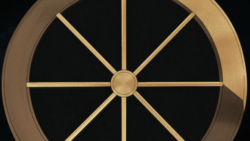
Fate is introduced as early as the first chapter of the series as an overarching force behind all things, and its influence is cited throughout the story. The exact nature and will of fate is never defined; nevertheless, by the end of Stone Ocean, it is understood to be a force that ultimately favors justice, even if it appears otherwise at points.[1] The Joestar bloodline is deeply tied to fate, with each generation destined to confront forces of evil, beginning with Jonathan Joestar's sacrifice against Dio Brando.[2][3]
Fate's existence is tangibly demonstrated several times throughout the series. Rolling Stones is directly stated to draw its energy directly from the power of fate, and Made in Heaven's ultimate purpose relies upon fate's existence and immobility. Cinderella is also said to use its power to affect fate directly. Other Stands such as Tohth and King Crimson, as well as certain talented individuals such as Tonpetty, are able to predict events that will occur in the near future with certainty, but with the caveat that said events cannot be altered in any way, only misunderstood. Even in King Crimson's case, events can only be removed entirely by erasing the period of time in which they occur. However, these and other powers that "reshape fate" are also accounted for by fate in advance, and as such only further play into its goals.[4]
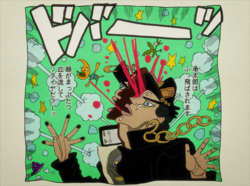
Though fate's grander shape generally remains unknown, certain patterns are identified within the story. The foremost example of these patterns is the idea of "gravity" between certain people that are fated to meet each other.[5] According to Toshikazu Hazamada, such a force acts on all Stand users, guiding them to meet each other either as friends or foes.[6] Enrico Pucci devotes himself to this idea, using it to justify various phenomena that aid him in his goals.[7] Ultimately, though the literal force of gravity is what allows Pucci to complete his Stand ability,[8] Emporio Alnino cites that very same gravity when explaining the priest's defeat.[1]
People can also exploit patterns in fate to infer its resolutions. Examples of this range from prophecies, such as the Red Stone of Aja being necessary to defeat the Pillar Men,[9] to fortune-telling performed by Wang Chan, Muhammad Avdol, and others. For example, Wang Chan predicts that Dio won't be caught by the police in the Joestar Mansion because he was born with impenetrable luck, based on the attributes of his face and the three moles on his ear.[10] Individuals such as Yoshikage Kira and Diavolo may also develop the idea that they have been favored by fate, though such beliefs are not guaranteed to be accurate.
Related Phenomena
Feng Shui

Feng Shui (風水, Fūsui, lit. Wind and Water), also called
Kenzou survived his cult's mass suicide by unknowingly standing in a lucky area, which was protected from the debris of the collapsing building he was inside. After being sent to prison, Kenzou harnessed the power of feng shui to perform assassinations, taking advantage of the lucky and unlucky areas of the human body to target their weak points while protecting himself from attack.[11] Kenzou's technique eventually manifested as Dragon's Dream, whose form includes both an arrow pointing to unlucky directions and a compass pointing to lucky directions; these allow Kenzou to determine the best course of attack at a glance, but also provide the same information to his opponents.[12]
Happiness
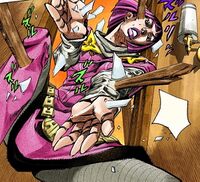
Happiness (幸福, Kōfuku) is a concept in Steel Ball Run that serves as the basis of the Saint's Corpse's power. Within the world, there is a balance of fortune and misfortune such that the two level out overall. The Saint's Corpse, when fully assembled, is able to manipulate that fortune by repelling misfortune from itself and its owner, leaving only good fortune and a state of "happiness" around both.[13] The only known exception to this principle is the law of gravity; as such, it can be overcome by gravity such as that created by two of the same person from parallel worlds existing in the same world,[14] or bypassed entirely by beings of infinite energy like Ball Breaker and Tusk ACT4.[15][16]
Upon awakening the corpse's power, Funny Valentine also gains the ability D4C Love Train, which creates a seam of light that Valentine can traverse and manipulate freely. However, Love Train is as much an evolution of his own Stand as it is an ability bestowed by the corpse; as such, the successor to the corpse's power (namely Parallel World Diego) does not gain a similar ability.[17]
Flow
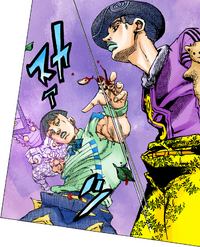
Flow (流れ, Nagare) is a concept in JoJolion proposed by Norisuke Higashikata IV. Norisuke believes that there is a "flow" or natural path for everything in life, even a simple fruit parlor, and that determining and accepting it is sure to lead one to their goal. This idea is later expanded by a natural law called Calamity (厄災, Yakusai), which functions as the basis behind Wonder of U, Toru's Stand.[18]
Calamity is an unavoidable negative energy that causes unfortunate events to occur as part of flows. In its natural state, it affects people at random, regardless of morality or circumstance, and regardless of whether they've made any mistakes or accepted the flows of things.[19] The law of calamity can manifest grievous misfortunes via any means necessary. For instance, calamity causes rain drops to pierce Josuke Higashikata, giving him near-lethal wounds,[20] and a falling leaf to slice off Joshu Higashikata's fingers.[21] Calamity can also manifest as an unfortunate chain of events: according to Mitsuba Higashikata, Yasuho Hirose's discovery of the New Locacaca fruit and Norisuke subsequently being incapacitated is also a part of the ongoing calamity targeting her and her family.[22]
To those who can see Stands, calamity is accompanied by a vision of Toru's Stand, Wonder of U, even after Toru's demise. The only known forces capable of averting an occurrence of calamity are those that transcend the flow of logic itself, such as the Spin as applied by Soft & Wet: Go Beyond.[23]
Mechanisms
Mechanisms (
Related Abilities
Creation and Development
Although he does not believe in God, Hirohiko Araki himself harbors a belief in some kind of overarching force, including the concept of fate. By extension, Araki believes that tackling subjects such as fate in his works, through proxies such as bloodlines, is what gives them meaning;[25] Araki thinks similarly of other works as well, praising works from The Book to Spider-Man for addressing the presence of destiny.[26][27] Nonetheless, he considers such factors to be an inevitability in the realm of manga, being determined by the circumstances of the work.[28]
However, Araki also believes that being unable to escape one's fate is more terrifying than death itself.[29] As such, he greatly admires and aims to write characters who move forward without consideration for fate, indirectly confronting and surpassing it in the process.[30][31] To Araki, the ability to move forward and carve out one's own fate is the greatness of humanity that he aims to celebrate in his manga.[32][33]
References
- ↑ Jump up to: 1.0 1.1 Stone Ocean Chapter 158: What a Wonderful World
- ↑ Chapter 116: Jotaro Kujo, Part 3
- ↑ Chapter 117: The Man with the Star Birthmark
- ↑ Stone Ocean Chapter 157: Made in Heaven, Part 9
- ↑ Chapter 17: The Birth of DIO
- ↑ Chapter 294: Yukako Yamagishi Falls in Love, Part 1
- ↑ Stone Ocean Chapter 136: Heavy Weather, Part 12
- ↑ Stone Ocean Chapter 148: C-MOON, Part 8
- ↑ Chapter 76: Ripple Teacher Lisa Lisa, Part 6
- ↑ Chapter 11: The Stone Mask, Part 4
- ↑ Jump up to: 11.0 11.1 Stone Ocean Chapter 67: Enter the Dragon's Dream, Part 1
- ↑ Stone Ocean Chapter 68: Enter the Dragon's Dream, Part 2
- ↑ Steel Ball Run Chapter 88: Break My Heart, Break Your Heart, Part 1
- ↑ Steel Ball Run Chapter 95: The World of Stars and Stripes - Outro
- ↑ Steel Ball Run Chapter 83: Ball Breaker, Part 1
- ↑ Steel Ball Run Chapter 86: Ball Breaker, Part 4
- ↑ Steel Ball Run Chapter 78: D4C, Part 11 -Love Train-
- ↑ JoJolion Chapter 99: The Wonder of You, Part 16
- ↑ JoJolion Chapter 98: The Wonder of You, Part 15
- ↑ JoJolion Chapter 90: The Wonder of You, Part 7
- ↑ JoJolion Chapter 104: The Wonder of You, Part 21
- ↑ JoJolion Chapter 95: The Wonder of You, Part 12
- ↑ JoJolion Chapter 108: Go Beyond, Part 2 Tailpiece
- ↑ The JOJOLands Chapter 1: Departure
- ↑ THRILL (September 2001)
- ↑ Araki x Otsuichi - The Book (December 2007)
- ↑ Playboy (July 2004)
- ↑ Monsoon Vol. 2 (March 1999)
- ↑ Quick Japan (December 2007)
- ↑ Vento Aureo Paperback Vol. 10 (August 2005)
- ↑ XxxHolic Guidebook (November 2006)
- ↑ Da Vinci (August 2005)
- ↑ Anime News Network (June 2017)
